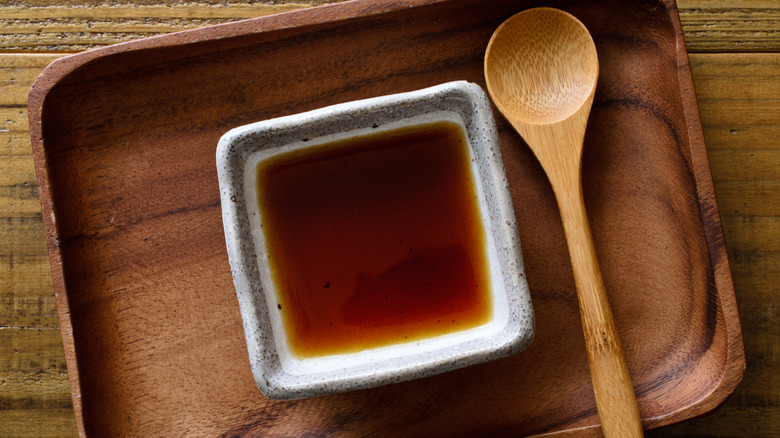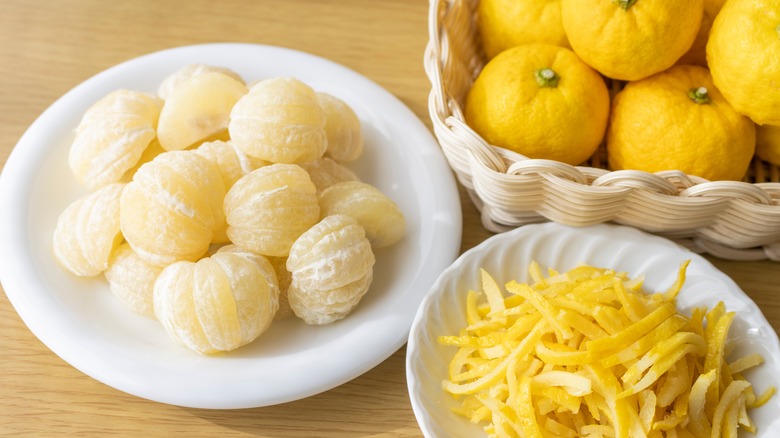What's The Difference Between Ponzu Sauce And Yuzu?
You may have had ponzu sauce at a Japanese restaurant before, but the telltale sign of traditionally-made ponzu is the taste of yuzu. Yuzu is an Asian fruit belonging to the citrus family, which looks like a smaller lemon with rough, bumpy skin. Its flavor runs the gamut of notes found within that particular fruit group, and is often described as a cross of a tart lemon and a sweet orange, or even grapefruit with a touch of lime and tangerine. The fruit grows well in colder climates and is used for beverages, sauces, marinades, and more in Japanese cuisine — including the famous ponzu sauce.
Ponzu recipes have many slight variations, but its base ingredients are simple. It almost always uses a mixture of soy sauce plus yuzu juice, or juice from a similarly-flavored fruit such as lemon or sudachi, a Japanese citrus. The sauce also often contains rice wine vinegar, mirin (rice wine), and/or dashi (stock made with fish flakes and kelp). Its taste can be compared to a saltier balsamic vinegar or a tart and citrusy soy sauce.
When grocery shopping, you may see sauces labeled "yuzu ponzu sauce" or simply "yuzu sauce". If the product looks like ponzu under another name, it's likely a good pick, as you can be sure that yuzu is the citrus of choice in that particular ponzu.
Ponzu sauce is for dipping and more
The name ponzu has both Dutch and Japanese influences, and roughly translates to "punch vinegar." Though it resembles soy sauce in appearance and partially in taste, ponzu sauce has a distinct and fruity flavor that is considered inimitable by many, and yuzu is a driving ingredient.
Ponzu sauce is primarily used as a dipping sauce for everything from sashimi to noodles to dumplings, as well as shabu shabu (hot pot) and tempura. It is also a nice addition to season a steaming bowl of white rice. The acid from the citrus also makes for a great marinade, perfect for making sticky sweet chicken wings or even a fresh summer ceviche. Ponzu sauce is also delicious drizzled over grilled fish, meats, and vegetables.
Ponzu sauce is readily available in grocery stores and online. Bottled options often contain added sugar to enhance the sweet-and-sour flavor, and may be more likely to use lemon or lime as opposed to the more costly yuzu juice. If you're up for making your own ponzu sauce, there are plenty of more complex recipes available online, but a simple mix of soy sauce, yuzu juice, mirin, and rice vinegar will do. You can even just combine soy and yuzu in a pinch. Try making a whole red snapper with ponzu or fry up homemade tempura and use it for dipping.
Yuzu juice is for more than just ponzu sauce
In the United States, yuzu is a bit harder to find than ponzu. It is not allowed to be imported due to the risk of bringing plant diseases from other countries. However, some farmers, mostly in California, do grow the fruit, and you can find yuzu juice at many specialty markets or online. If you're lucky enough to come across a whole yuzu fruit at a farmer's market or in the produce aisle, it has a variety of uses.
The fruit's peel and zest can be used as a garnish or candied, much like with an orange or lemon rind. The fresh fruit can also yield a zingy homemade marmalade for your morning toast. Fresh yuzu juice is great squeezed over seafood or splashed in cocktails. It's used to make other Asian-inspired condiments, such as yuzu kosho, a paste made with fermented hot chilies, or mix it with miso for a creamy sauce. You can also mix yuzu with vinegar for salad dressings.
Yuzu juice is a particularly popular ingredient in desserts that benefit from a splash of citrusy brightness, like a cheesecake or tart, and yuzu bars make for a fun spin on classic lemon bars. You may come across dried yuzu peel or powdered yuzu in stores, which is great in spice mixes. The fruit's' popularity in the U.S. has been on a rapid rise – Trader Joe's even makes a fan-favorite yuzu hot sauce.



